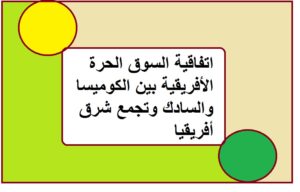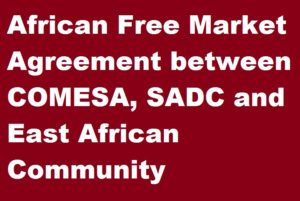اتفاقية السوق الحرة الأفريقية بين الكوميسا والسادك وتجمع شرق أفريقيا
سعت دول القارة الأفريقية منذ الأستقلال الى تحقيق التكامل الأقليمي بين مناطق القارة المختلفة، إيماناً منها بأهمية هذا التكامل في رفع مستوى معيشة شعوبها ، و تحقيق التنمية المستدامة من خلال رفع الكفاءة الاقتصادية و القدرات الأفريقية في كافة المجالات . و قد أكدت خطة عمل لاجوس منذ أكثر من ثلاتة عقود على إلتزام القادة الأفارقة بتعزيز التكامل الأقتصادي في أفريقيا ، وتسهيل أمكانية إنشاء الجماعة الأقتصادية الأفريقية ، و هو ما تم أستكماله و التأكيد عليه من خلال معاهدة أبوجا التي بدأ العمل بها منذ عام 1994 ، و التي تهدف الى الوصول للأتحاد الأقتصادي و النقدي لأفريقيا بحلول عام 2028.

و تأتي مبادرة إنشاء السوق الحرة الأفريقية بين التجمعات الاقتصادية الثلاث ، الكوميسا و السادك و تجمع شرق أفريقيا كخطوة لتحقيق الأهداف الأوسع للأتحاد الأفريقي ، والمنصوص عليها في أتفاقية أبوجا , والتي تسعى الى الوصول الى الجماعه الاقتصادية الأفريقية ، و تضم منظمة التجارة الحرة الثلاثية للتكتلات الأفريقية 26 دولة أفريقية ،بإجمالي عدد سكان يتجاوز 600 مليون نسمة ، وناتج محلي إجمالي يقدر بحوالي 1,3 تريليون دولار ، بنسبة 60% من إجمالي أقتصاد القارة . وهو ما يمثل فرصة كييرة أمام الدول الأعضاء في التجمعات الاقتصادية الثلاث بصفة عامه ومصر بصفة خاصة ؛ للأستفادة من المنافع الناشئة عن توسعة السوق ، وزيادة حجم الأستثمار، و تحفيز التصنيع ، و تحسين القدرة التنافسية للمنتجات … ألخ
ومن هنا كانت أهمية دراسة التحديات و الأفاق المستقبلية أمام أتفاقية السوق الحرة الأفريقية الثلاثية ، حيث تهدف هذه الدراسة الى تقديم شرح موجز عن تطور أنشاء منطقة التجارة الحرة الثلاثية بين التجمعات الثلاث ، و تحديد الهدف من الأتفاقية ، وكذلك دراسة حالة التكامل الأقليمي داخل التجمعات الثلاث من خلال أستخدام مؤشر التكامل الأقليمي ، و هو مؤشر يعطي تقييماً لوضع التكامل الأقليمي بأبعاده المختلفة في التجمعات الاقتصادية الأفريقية المعنية ، و هو بذلك وسيلة لتسليط الضوء على مناطق الضعف والقوة بما يمكن من وضع تصورات أكثر ديناميكية للخطوات المستقبلية في مسيرة التكامل الاقتصادي الأفريقي ، كما تهتم الدراسة بعرض المنافع المرجح أن تجنيها الدول الأعضاء من جراء ترتيبات التجارة الحرة المزمع تطبيقها ، و المقترحات بشأن توسعة نطاق تلك المنافع .
تنقسم الدراسة الى أربعة أجزاء رئيسية :
أولاً : مفهوم الأتفاقية و تطور مراحل إنجازها.
ثانياً : حالة التكامل الأقليمي داخل تجمعات الكوميسا و السادك وتجمع شرق أفريقيا.
ثالثاً : المنافع المحتملة من إقامة منطقة التجارة الحرة الثلاثية.
رابعاً : الأفاق المستقبلية للتكامل الأقليمي الأفريقي.
اعداد/ د. غادة أنيس البياع
مدرس الاقتصاد– قسم السياسة والاقتصاد
معهد البحوث والدراسات الأفريقية – جامعة القاهرة
اتفاقية السوق الحرة الأفريقية
التبادل التجارى بين مصر ودول حوض النيل
African Free Market Agreement between COMESA, SADC and East African Community Prospects and Challenges
Since independence, the countries of the African continent have sought to achieve regional integration between the different regions of the continent, believing in the importance of this integration in raising the standard of living of their peoples, and achieving sustainable development by raising economic efficiency and African capabilities in all fields. For more than three decades, the Lagos Plan of Action has affirmed the commitment of African leaders to promote economic integration in Africa and to facilitate the possibility of establishing the African Economic Community, which has been complemented and affirmed by the Abuja Treaty, which has been in force since 1994, and which aims to achieve the Economic and Monetary Union of Africa by 2028.
The initiative to establish the African free market between the three economic groupings, COMESA, SADC and the East African Community comes as a step to achieve the broader objectives of the African Union, stipulated in the Abuja Agreement, which seeks to reach the African Economic Community, and the tripartite free trade organization of the African blocs includes 26 African countries, with a total population of more than 600 million people, and a gross domestic product estimated at about 1.3 trillion dollars, or 60% of the total economy of the continent. This represents a great opportunity for the member states of the three economic groupings in general and Egypt in particular to benefit from the benefits arising from market expansion, increasing the volume of investment, stimulating industrialization, improving the competitiveness of products… etc.

Hence the importance of studying the challenges and future prospects in front of the tripartite African free market agreement, as this study aims to provide a brief explanation of the development of the establishment of the tripartite free trade area between the three groupings, and determine the objective of the agreement, as well as studying the state of regional integration within the three groupings through the use of the regional integration index, which is an indicator that gives an assessment of the status of regional integration in its various dimensions in the African economic groupings concerned, and it is thus A means of highlighting areas of weakness and strength in order to develop more dynamic perceptions of future steps in the process of African economic integration, and the study is also concerned with presenting the benefits likely to be derived by member states as a result of the free trade arrangements to be applied, and proposals on expanding the scope of those benefits.
The study is divided into four main parts:
First: The concept of the agreement and the development of the stages of its completion.
Second: The state of regional integration within the COMESA, SADC and East African communities.
Third: The potential benefits of establishing a tripartite free trade area.
Fourth: Future prospects for African regional integration.